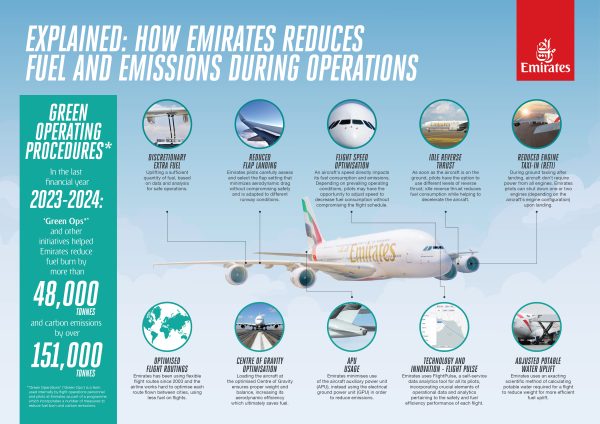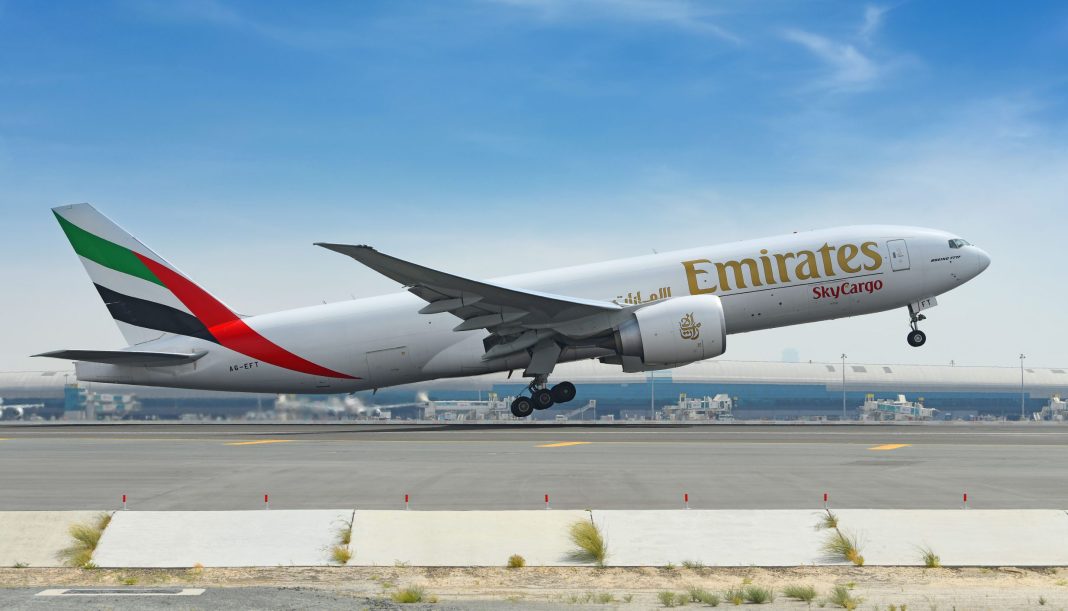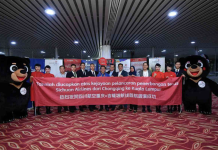DUBAI, 25 June 2024: Flying smarter and maintaining a strong focus on minimising fuel consumption and emissions starts in the cockpit.
Emirates implemented ‘Green Operating Procedures’ (‘Green Ops’)* in 2016, taking a multi-pronged approach that looks for opportunities to reduce on-ground and in-flight fuel use. In addition, it provides pilots with the necessary education, awareness, data analytics, and technology to help them manage their flights as efficiently as possible.
Led by an internal cross-functional Operations Efficiency Steering Group, the airline aims to mitigate unnecessary fuel burn and emissions wherever possible while ensuring the highest safety standards embraced by Emirates are never compromised. In the last financial year, 2023-2024, ‘Green Ops’ and other operating initiatives helped Emirates reduce fuel burn by more than 48,000 tonnes and carbon emissions by over 151,000 tonnes.
Here are some of the key operational measures taken in the air and on the ground to reduce unnecessary fuel burn and emissions:
Discretionary Extra Fuel
The flight commander ensures that each flight uplifts enough fuel for safe operations. Depending on the assessment of prevailing operational circumstances, the Captain may choose to uplift extra fuel beyond the minimum stipulated by regulatory standards. This initiative encourages the Captain to uplift extra fuel based on well-founded judgment and legitimate operational needs. The goal is to furnish Captains with pertinent data and analysis, aiding them in making more informed and precise decisions regarding the uplift of extra fuel. With this initiative, the increase in discretionary extra fuel has been reduced significantly.

Flight speed optimisation
An aircraft’s speed directly impacts its fuel consumption and emissions. To accurately calculate the optimised speed for a flight, some considerations are made based on a thorough calculation that seeks to minimise total operating costs while maintaining adherence to departure and arrival schedules. Depending on prevailing operating conditions, pilots may have the opportunity to adjust speed to decrease fuel consumption without compromising the integrity of the flight schedule.
Reduced flap landing
Aircraft have the flexibility to land using a variety of flap configurations. Emirates pilots carefully assess and select the flap setting that minimises aerodynamic drag, reducing fuel consumption as a result. This decision is made without compromising safety and is adapted to different runway conditions.
Idle reverse thrust
Pilots can use different levels of reverse thrust, providing backward thrust to decelerate the aircraft as soon as it is on the ground. Based on prevailing conditions and runway length, Emirates pilots will prioritise using idle reverse thrust to reduce fuel consumption.
Reduced engine taxi-in (RETI)
Once they have landed, aircraft don’t require power from all engines during ground taxiing. Emirates pilots take advantage of every opportunity to engage in reduced engine taxiing by shutting down one or two engines (depending on the aircraft’s engine configuration) upon landing. This practice is implemented without compromising safety or operational efficiency.
Optimised flight routings
Emirates has been using flexible flight routes since 2003 as a pioneer and early adopter of flight planning efficiencies. Working directly with air traffic control and other industry bodies across its network, the airline works hard to optimise each route flown between cities. Optimising routings enables Emirates to carry and use less fuel on flights, resulting in lower emissions.
Technology and Innovation – Flight Pulse
Emirates introduced FlightPulse (collaboratively developed with GE Digital Aviation Services), an extensive self-service data analytics tool to all its pilots, incorporating crucial elements of operational data and analytics pertaining to each flight’s safety and fuel efficiency performance. This tool has significantly transformed the monitoring of flight operations data. The rollout of FlightPulse has fostered improved collaboration between Flight Operations management and the pilot community at Emirates, ultimately enhancing the safety and efficiency of flights. This initiative demonstrates the airline’s commitment to industry innovation through technology adoption to improve fuel efficiency.
Centre of Gravity Optimisation
The aircraft’s centre of gravity (CG) significantly influences the safety and efficiency of a flight. Loading the aircraft at the optimised Centre of Gravity ensures proper weight and balance, increases its aerodynamic efficiency, and ultimately saves fuel. Emirates has a rigorous policy of loading aircraft to come as close as possible to the ideal trim line to minimise fuel burn.
APU Usage
One way Emirates reduces fuel consumption on the ground is by minimising the use of the aircraft auxiliary power unit (APU) and instead using the electrical ground power unit (GPU) to reduce emissions. APU use has been reduced by over 30% since the introduction of this initiative.
Adjusted potable water uplift
Emirates uses an exacting scientific method of calculating potable water required for a flight to reduce weight for more efficient fuel uplift. Each flight uploads the required amount of potable water without compromising passenger comfort.
*“Green Operations” (‘Green Ops’) is a term used internally by Emirates’ flight operations personnel and pilots to describe a programme that incorporates several measures to reduce fuel burn and carbon emissions.
For flight information and to make bookings, head to the website www.emirates.com.







